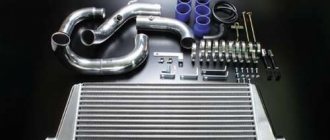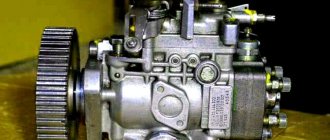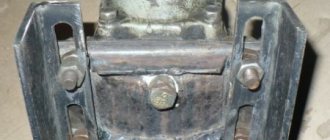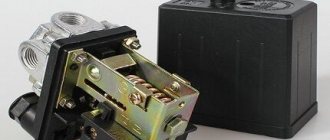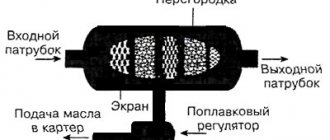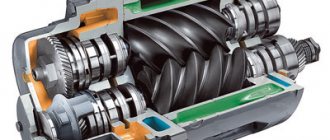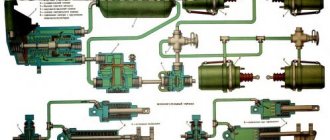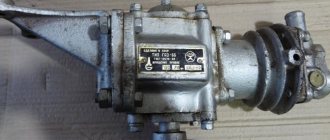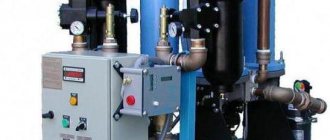Why do you need a receiver in a compressor?
The receiver included in the supercharger provides a solution to several complex problems, in particular:
- Guarantees stable pressure of the working medium transported to consumers.
- Provides gas transportation at a time when the compressor begins to operate intermittently, or an additional consumer is connected to the air supply system.
- Cleaning the compressed air mixture from accumulated moisture.
- The accumulation of gas in this container leads to a decrease in vibrations in the compressor. This in turn reduces the level of force loads affecting the foundation.
- To carry out work that involves producing a large amount of gas normally, the installed vessel may not be enough, so instead of purchasing and installing a stronger compressor, an additional tank is installed on the old compressor.
- The receiver ensures that the compressor is turned on at a certain frequency, and this leads to a decrease in electrical energy consumption.
In essence, a compressor receiver is a container of a certain size. For mobile compressors, containers with a volume of 50 to 100 liters are used. For stationary units, receivers with a volume of up to 1000 liters are used.
Filters are installed on them, which purify the gas from moisture; in addition, the design of the receiver includes condensate drains and shut-off valves. It is used to connect the compressor to consumers.
For the manufacture of receivers, corrosion-resistant steels 10HSND or 16GA2F are used, meanwhile, in rare cases, polymers or high-strength elastomers are used for low-power units.
Manufacturers produce two types of containers - horizontal and vertical. The first version is used for mobile type compressors, the second version is used for stationary compressors.
Each of the versions has its own advantages and disadvantages. For example, in a vertical design it is easier to drain water, while horizontal ones are more compact in size and require shorter pipelines.
How to choose the optimal receiver parameters
Like any technical product, the receiver has a number of technical parameters. Among them are:
- Volume, l.
- Humidity.
- Operating parameters, that is, limit values of humidity and temperature.
- Characteristics of the installation location of the compressor unit. It must be installed away from sources of heat, fire and explosive substances. The presence of foreign particles in the air is undesirable, for example, in procurement areas.
Safety rules state that it is unacceptable to use receivers that have not passed the appropriate test, on the surface of which there are mechanical damage in the form of cracks and traces of corrosion.
The selection of a receiver is carried out on the basis of a fairly simple calculation:
- The required flow rate of the air mixture, the duration of the flow rate, and the maximum operating pressure are determined.
- Using special calculation tables, they exist both in paper form and as Internet applications. For example, with a productivity of 0.1 cubic meters per minute, a maximum load duration of 5 minutes and within a pressure range of 3/4 (min/max), the volume of the receiver will be about 500 liters.
This method of calculation is focused on the time required to completely empty the container.
There is another technique based on the ratio of the volume of the vessel and the power of the air compressor. In practice, the following ratios are used:
- Power 5 kW, volume max – 100 l.
- Power 10 kW, volume max – 300 l.
- Power 20 kW, volume max - 550 l.
There are also experimental dependencies, for example, the volume of the receiver cannot be less than the amount of air that the compressor can produce for 8 seconds of operation. For example, the flow rate is 400 liters per minute, respectively, the volume of the poppy must be at least 53 liters.
Here you can select and buy air receivers for compressors.
Basic criteria for choosing air collectors
After reading this article, you learned why you need a receiver in a compressor, what types of tanks there are, and how to install two or more storage tanks. In conclusion, we suggest that you study the main parameters that require attention when purchasing equipment.
- Volume. This figure varies from 5 liters (for household models) to 1000 or more liters (for industrial units). When choosing, you should adhere to the rule: the more powerful the compressor, the larger the receiver. On average, its volume should be about 30-50% of the unit’s productivity.
- Pressure. For use in conjunction with household tools, a receiver designed to store air under pressure up to 10 bar is usually sufficient. For commercial use in small businesses, models that can withstand up to 16 bar are suitable.
- Bandwidth. This parameter determines how much air (in liters) the receiver can pass through in one minute. The higher the demand for compressed gas, the greater the throughput of the air collector must be.
Based on these selection criteria, you can select equipment that is optimally suited for the given operating conditions.
When starting this article, we planned to answer the common question about why a receiver is needed in a compressor. But we couldn’t help but touch on the topic of choosing and using compressed air storage devices. We hope that our tips will be useful. If you still have questions, we invite you to take advantage of professional help in selecting a compressor receiver. To consult with a specialist from Energoprof Group of Companies, contact us at the toll-free phone number listed on the website.
Do-it-yourself additional receiver for a compressor
Some work performed in a home workshop or garage requires compressed air. And a situation may arise when a household compressor cannot cope with the task. In this case, the situation can be resolved by installing an auxiliary receiver on the existing unit. This device can either be purchased at a specialized store, for example, car spare parts. There you can buy a receiver for the KAMAZ pneumatic system, or make it yourself.
Most of the receivers offered are made for a specific model and are distinguished by a high price. Depending on the planned size of the DIY container, you can use either a propane cylinder or a fire extinguisher body.
The procedure for making a homemade receiver
The sequence of manufacturing an additional vessel looks approximately as follows.
- Cleaning an old vessel from gas residues. To do this, you will need to clean it of gas residues. The inlet valve is removed, while using an electric tool, for example, an angle grinder, gas residues may remain in the housing.
- The vessel is filled with water and allowed to stand for 24 hours. Then it is drained and the internal cavity is cleaned of dirt.
- After this, splitters under the sleeves are welded into the cylinder, but it is also permissible to install threaded fittings; to increase the tightness when installing plugs, it is necessary to install sealing gaskets.
- A homemade receiver must be painted with weather-resistant paint.
- A condensate drain is installed in the assembled and painted maneuver - its place is at the lowest point of the tank, and a pressure gauge is installed in the upper part. The brand of condensate drain must be consistent with the compressor capacity and thread sizes. The cost of such a device ranges from 2500 to 3000 rubles.
When operating a condensate trap, we must not forget that its installation on an auxiliary gas storage tank is mandatory. Before switching on the operating load, it is necessary to check the condition of the electric drive to ensure that it can be operated with an auxiliary gas container.
To do this check, you need to turn on the compressor and use a flow meter to check the pressure surge during long-term operation (about 20 minutes).
If the minimum pressure corresponds to the declared characteristics of the supercharger, then operation of the assembled structure is quite acceptable. If the pressure drop is below the permissible level, then the use of this equipment is in question and it is undesirable to use it.
Directory
An air receiver is a vessel operating under pressure.Designed for accumulation and storage of compressed air; to equalize and maintain pressure in pipelines; softening pulsations caused by compressor operation; maintaining the required operating mode of the compressor and reducing the number of its bypasses; primary cooling of compressed air; collection and removal of condensate.
Persons over 18 years of age who have previously completed industrial training, labor safety certification and instruction on the safe maintenance of pressure vessels are allowed to service air receivers (air collectors).
1. The compressed air receiver is a welded structure, manufactured in accordance with the requirements of OST 26 291-94 “Welded steel vessels and apparatus. General technical conditions" and PB 03-576-03 "Rules for the design and safe operation of pressure vessels."
On the shell and bottom of the air collector there are threaded bosses: for connecting pipelines supplying and discharging the working medium from the receiver - compressed air; for installing a safety valve and pressure gauge; for installing a valve, a plug for draining condensate; there is a flange, the hole of which serves as a hatch for inspecting the inner surface of the vessel (see Figure 1).
2. A plate with information about the manufacturer, technical characteristics and operating parameters of the receiver must be attached to the air collector.
Changing the working environment and parameters of the air receiver specified in the passport is not allowed.
3. Installed fittings, instrumentation and safety devices must comply with the parameters specified in the passport for the pressure vessel (receiver - air collector).
The pressure gauge must be installed so that its readings are clearly visible to operating personnel. The operating pressure measurement limit should be in the second third of the pressure gauge scale. The owner of the receiver must mark a red line on the pressure gauge scale, indicating the operating pressure in the vessel. Instead of the red line, it is allowed to attach a metal plate painted red to the pressure gauge body and tightly adjacent to the pressure gauge glass.
A sealed safety valve must be installed on the receiver to protect the receiver from pressure exceeding the permissible value. If, when the valve is opened, air comes out and there is no increase in pressure in the receiver, and when the ring or blasting head is lowered, the valve closes and remains tight, the valve is considered to be in good condition.
4. Operating conditions of the air collector:
— altitude above sea level no more than 1000m;
— ambient temperature from 253K (-20°C) to 313K (+40°C);
— relative air humidity no more than 80% at 298K (+25оС)
5. The air receiver can be transported by any type of transport, taking into account the requirements of the Rules in force for the corresponding type of transport.
6. The receiver should be packaged during transportation in wooden boxes or using lightweight transport packaging, on securely fastened wooden supports, while the receiver can be packed in plastic film.
The threads of the holes must be preserved by applying inhibited oils and closed with plugs or plugs. Separately supplied parts and components must also be preserved and packaged in a plastic bag.
Technical and shipping documentation must be packed in a plastic bag.
7. Storage conditions for the air collector – closed, unheated room. The storage method must prevent mechanical damage and corrosion of the receiver.
When storing an air receiver for more than a year, provided it is stored in a closed, unheated room, the receiver must be re-preserved. To do this, it is necessary to depreserve the receiver: remove all plugs and plugs; Use a rag moistened with a degreaser to remove previously applied preservation from surfaces; wipe with a dry cloth; Apply the preservation again (see point 6).
8. It is not allowed to use threaded bosses as hooks to lift the receiver and move it.
9. It is prohibited to alter, weld, insert or install devices that violate the integrity of the air collector receiver.
10. The owner is obliged to ensure that the receiver is maintained in good condition and safe working conditions in accordance with the requirements of the relevant sections of PB 03-576-03 “Rules for the design and safe operation of pressure vessels.”
To do this, it is necessary to appoint by order from among the specialists responsible for the good condition and safe use of the air receiver, as well as those responsible for supervising the technical condition and operation of the air receiver.
The owner must develop and approve in accordance with the established procedure instructions for the operation and safe maintenance of the air receiver.
11. The air collector is installed in ventilated industrial premises in places that exclude crowds of people and should not be located near heat sources; flammable substances and substances that cause increased metal corrosion; in places of high air pollution.
The installation of the air collector must provide the possibility of inspection, repair and cleaning from the inside and outside.
12. Before installing the air collector, it is necessary to check the availability of a set of technical and shipping documentation; completeness of delivery in accordance with technical and shipping documentation.
Check the general condition of the receiver: no damage, nicks, dents, or deformations that may occur during transportation and storage.
13. During installation, the air collector must be fixed to the foundation. The installation of the air collector must prevent it from tipping over.
To reduce vibration transmitted to the receiver from a running compressor and other equipment, rubber shock absorbers (pads) must be provided under the receiver's feet.
Install the pressure gauge and safety valve into the appropriate mounting points on the receiver, removed for transportation; install shut-off devices, install pipelines. Check the tightness of all connections.
14. The air receiver must be operated in accordance with the Rules for the Design and Safe Operation of Pressure Vessels and in accordance with safety requirements.
Operation of the receiver is PROHIBITED in the following cases:
- if the pressure and (or) temperature values go beyond the limits specified in the passport and on the receiver plate;
— when identifying a malfunction of installed fittings, instrumentation and safety devices;
- if leaks, bulges, or rupture of gaskets are detected in the receiver and its elements operating under pressure;
- in the event of a fire that directly threatens the receiver under pressure.
If these malfunctions are detected, you must:
— stop the supply of compressed air;
— reduce the pressure in the receiver to atmospheric pressure.
15. The air collector (air receiver) must be subjected to an initial technical examination before being put into operation; and undergo periodic inspection during operation; in necessary cases - an extraordinary examination.
A technical examination is carried out to establish the serviceability of the receiver and the possibility of its further operation.
15.1. Technical inspection must be carried out by a person responsible for supervising the good condition and safe operation of the air collector in the organization where the air collector is operated.
15.2. During the initial survey the following should be carried out:
— checking technical documentation, external inspection for damage and checking that the receiver (pressure vessel) is installed correctly and equipped in accordance with the Rules;
15.3. During periodic surveys the following should be carried out:
-checking technical documentation - at least once a year;
-external inspection of all welds and surface of the vessel - annually;
-internal inspection of the corrosion state of the vessel walls - annually, using a hatch and holes. If the internal surface is not completely visible through the existing holes, then the internal surface is examined using special instruments (endoscope, periscope and other viewing devices);
- hydraulic test with test pressure after 5 years (subsequently - based on the results of control and testing).
Based on the results of the examination, the technical diagnostics program for the vessel can be supplemented by monitoring the thickness of the vessel wall using the ultrasonic method.
15.4. When conducting an extraordinary survey, the reason that necessitated such a survey must be indicated.
15.5. The results of the technical examination must be recorded in the vessel's passport, indicating the permitted operating parameters of the vessel and the timing of the next examinations in accordance with the Rules.
16. For receivers that have completed their design service life established by the manufacturer, the volume, methods and frequency of technical examination must be determined based on the results of technical diagnostics and a decision must be made to extend the service life of the receiver, indicating the permitted operating parameters, or to write it off.
Receivers that have reached the end of their service life and (or) based on the results of technical diagnostics are determined to be impossible for further operation, must be disposed of in accordance with current sanitary standards; parts and components must be transferred to a specialized enterprise approved by the sanitary and epidemiological service, which has a permit (license) from the Ministry of Natural Resources of the Russian Federation.
17. To maintain the receiver in good condition, the owner of the receiver is obliged to carry out timely repairs.
Receiver repair consists of restoring the protective coating and replacing fittings, instrumentation and safety devices, the condition of which does not ensure the reliability of their further operation.
Requirements for instrumentation, safety devices and other fittings installed on the air collector (receiver); the parameters of compressors allowed for connection are specified by the manufacturer in the operating manual for the specific compressor model in which the vessel is used.
When repairing, safety requirements set out in industry rules and regulations must be observed.
After carrying out repair work, the proper operation of the fittings, instrumentation and safety devices must be checked; density of all connections. The scope of repairs performed and its results must be entered in the passport of the pressure vessel.
MANUFACTURER'S WARRANTY
The guaranteed service life of the air collector (receiver) is 12 months from the date of commissioning, but not more than 15 months from the date of shipment from the manufacturer and subject to storage before commissioning in a clean and dry room.
